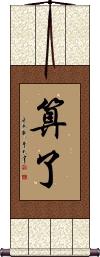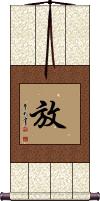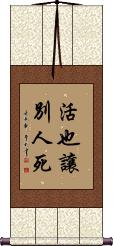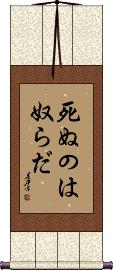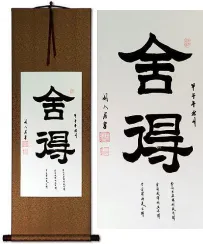Many custom options...
And formats...

Let It Be in Chinese / Japanese...
Buy a Let It Be calligraphy wall scroll here!
Personalize your custom “Let It Be” project by clicking the button next to your favorite “Let It Be” title below...
Let It Be
Release / Let Go
放 means to release, to free, to let go, to let out, to set off (fireworks).
In Japanese, this can also be a place called Hanashi
放 is also used in the context of Buddhism.
In Buddhism, this can represent the release of desire, materialism, suffering, or mortality.
Let It Be / Be Relieved
眉を開く is a Japanese proverb and expression that means “to feel relieved,” “to forget about one's troubles,” or “to settle into peace of mind.”
The literal words suggest relaxing your eyebrows or face. Allow worry or concern to go away, and just be content with “letting it be.”
Note: Because this selection contains some special Japanese Hiragana characters, it should be written by a Japanese calligrapher.
Forgive and Forget
略跡原情 is a Chinese proverb that means “to overlook past faults,” or “forgive and forget.”
It's more literally, “Abridge or make small the scars from your past emotions.” You should let it go.
The character breakdown:
略 (lüè) abbreviation; omission; abridge.
跡 (jī) ruins; scar; traces.
原 (yuán) former.
情 (qíng) feeling; emotion.
Live and Let Die
Live and Let Die
This in-stock artwork might be what you are looking for, and ships right away...
Gallery Price: $200.00
Your Price: $69.88
Not the results for Let It Be that you were looking for?
Below are some entries from our dictionary that may match your Let It Be search...
| Characters If shown, 2nd row is Simp. Chinese |
Pronunciation Romanization |
Simple Dictionary Definition |
放 see styles |
fàng fang4 fang hanashi はなし |
More info & calligraphy: Release / Let Go(place-name) Hanashi To let go, release, send out; put, place. |
聽 听 see styles |
tīng ting1 t`ing ting chō |
More info & calligraphy: ListenTo hear, listen, hearken; listen to, obey. |
無為 无为 see styles |
wú wéi wu2 wei2 wu wei mui むい |
More info & calligraphy: Wu Wei / Without Action(adj-na,adj-no,n) idleness; inactivity; (female given name) Mui |
算了 see styles |
suàn le suan4 le5 suan le |
More info & calligraphy: Let It Be |
まっせ see styles |
masse マッセ |
(expression) (ksb:) (on -masu stem of verb; roughly equiv. to -ますよ) let's do it; I (we) are going to do it; (personal name) Massais |
レット see styles |
reddo レッド |
More info & calligraphy: Lett |
對不起 对不起 see styles |
duì bu qǐ dui4 bu5 qi3 tui pu ch`i tui pu chi |
More info & calligraphy: Sorry / Apology |
水に流す see styles |
mizuninagasu みずにながす |
More info & calligraphy: Forgive and Forget |
下 see styles |
xià xia4 hsia shimo しも |
down; downwards; below; lower; later; next (week etc); second (of two parts); to decline; to go down; to arrive at (a decision, conclusion etc); measure word to show the frequency of an action (1) (ant: 上・かみ・1) lower reaches (of a river); (2) bottom; lower part; (3) lower half (of the body, esp. the privates); feces (faeces); urine; menses; (4) end; far from the imperial palace (i.e. far from Kyoto, esp. of western Japan); (can be adjective with の) (5) dirty (e.g. dirty jokes, etc.); (place-name, surname) Shimo hīna, adhara. Below, lower, inferior, low; to descend, let down, put down. |
任 see styles |
rèn ren4 jen makoto まこと |
to assign; to appoint; to take up a post; office; responsibility; to let; to allow; to give free rein to; no matter (how, what etc); classifier for terms served in office, or for spouses, girlfriends etc (as in 前任男友) obligation; duty; charge; responsibility; (given name) Makoto Bear, endure, let; office; it is used to connote laisser-faire; one of the 四病, as 任運 implies laisser-aller; it is intp. by let things follow their own course, or by 自然 naturally, without intervention. |
低 see styles |
dī di1 ti tei / te てい |
low; beneath; to lower (one's head); to let droop; to hang down; to incline (prefix) low (level, value, price, etc.) To let down, lower. |
垂 see styles |
chuí chui2 ch`ui chui sui すい |
to hang (down); droop; dangle; bend down; hand down; bequeath; nearly; almost; to approach (1) zigzag-shaped paper streamer often used to adorn Shinto-related objects; (2) hornbeam (deciduous tree in the birch family); (surname) Sui Drop, droop, let down, pass down; regard. |
揄 see styles |
yú yu2 yü yu |
to draw out; to let hanging To draw out, extol. |
曉 晓 see styles |
xiǎo xiao3 hsiao shou / sho しょう |
dawn; daybreak; to know; to let sb know; to make explicit (out-dated kanji) (out-dated or obsolete kana usage) dawn; daybreak; (out-dated kanji) (1) dawn; daybreak; (2) event (e.g. "in the event of ..."); occasion; occurrence; (female given name) Shou Dawn, shining, clear; to know, to make known. |
沰 see styles |
tuō tuo1 t`o to |
to let drop |
涼 凉 see styles |
liàng liang4 liang riyou / riyo りよう |
to let something cool down (See 涼を取る・りょうをとる) cool breeze; cool air; refreshing coolness; (female given name) Riyou cool |
滴 see styles |
dī di1 ti shizuku しずく |
to drip; to let drip; to apply (eye drops etc); (bound form) a drop (of liquid); classifier for drops of liquid (counter) counter for drops of liquid; (female given name) Shizuku |
燒 烧 see styles |
shāo shao1 shao shō |
to burn; to cook; to stew; to bake; to roast; to heat; to boil (tea, water etc); fever; to run a temperature; (coll.) to let things go to one's head To burn. |
由 see styles |
yóu you2 yu yoshitsugu よしつぐ |
to follow; from; because of; due to; by; via; through; (before a noun and a verb) it is for ... to ... (1) reason; significance; cause; (2) piece of information that one has heard; I hear that ...; it is said that ...; (personal name) Yoshitsugu From; by: a cause, motive; to allow, let; translit. yo, yu; e. g. 由乾; 由乾陀羅 由乾陁羅, Yugaṃdhara, idem 踰健達羅. |
縋 缒 see styles |
zhuì zhui4 chui |
to let down with a rope |
脫 脱 see styles |
tuō tuo1 t`o to datsu |
to shed; to take off; to escape; to get away from To take the flesh from the bones; to strip, undress, doff; to escape, avoid; let go, relinquish. |
舍 see styles |
shè she4 she sha |
(bound form) residence; house; (bound form) my (in speaking of relatives younger than oneself, as in 舍妹[she4 mei4]); (archaic) unit of distance equal to 30 li 里[li3] A shelter, cottage; used as a term of humility for "my"; to lodge; let go, relinquish. |
解 see styles |
xiè xie4 hsieh shie しえ |
acrobatic display (esp. on horseback) (old); variant of 懈[xie4] and 邂[xie4] (old) (1) {math} solution (of an equation, inequality, etc.); root (e.g. of a polynomial); (2) solution (to a given problem); answer; (3) explanation; interpretation; (surname) Shie To unloose, let go, release, untie, disentangle, explain, expound; intp. by mokṣa, mukti, vimokṣa, vimukti, cf. 解脫. |
語 语 see styles |
yù yu4 yü kataru かたる |
(literary) to tell; to let (sb) know (n,n-suf,ctr) (1) word; term; (n,n-suf) (2) language; (3) speech; (given name) Kataru Words, discourse, conversation, speech, language; to say, speak with; cf. 嚕 ruta. |
讓 让 see styles |
ràng rang4 jang yuzuru ゆずる |
to yield; to permit; to let sb do something; to have sb do something; to make sb (feel sad etc); by (indicates the agent in a passive clause, like 被[bei4]) (personal name) Yuzuru to yield |
錯 错 see styles |
cuò cuo4 ts`o tso saku こすり |
mistake; wrong; bad; interlocking; complex; to grind; to polish; to alternate; to stagger; to miss; to let slip; to evade; to inlay with gold or silver rubbing; scrubbing; scraping to mix |
さあ see styles |
saa / sa さあ |
(conj,int) (1) come; come now; come along; go on; hurry up; (2) well; who knows; I don't know...; uh; hmm; (3) (said when surprised or happy) well now; let's see; there we go; all right; (4) about that; you see |
よう see styles |
you / yo ヨウ |
(auxiliary verb) (1) (on non-五段 stem, e.g. 食べる→食べよう; indicates intention) (I) will; (I) shall; (auxiliary verb) (2) (on non-五段 stem; indicates suggestion or invitation) let's; (auxiliary verb) (3) (on non-五段 stem; indicates speculation) (I) wonder (if); might it be (that); maybe; perhaps; perchance; (personal name) Yaw |
下す see styles |
kudasu くだす orosu おろす |
(transitive verb) (1) to make a decision; to draw a conclusion; (2) to judge; to hand down a verdict; to pass sentence; (3) to let go down; to lower; (4) to do oneself; to do by oneself; (5) to beat; to defeat; (6) to have loose bowels; to have diarrhea; to pass excrement; (irregular okurigana usage) (transitive verb) (1) to take down (e.g. flag); to launch (e.g. boat); to drop; to lower (e.g. ladder); to let (a person) off; to unload; to discharge; (2) to drop off (a passenger from a vehicle); to let (a person) off; (3) to withdraw money from an account; (4) to wear (clothing) for the first time; (5) to fillet (e.g. a fish) |
不依 see styles |
bù yī bu4 yi1 pu i fue |
not to comply; not to go along with; not to let off easily; not to let sb get away with it not relying |
Click here for more Let It Be results from our dictionary
The following table may be helpful for those studying Chinese or Japanese...
| Title | Characters | Romaji (Romanized Japanese) | Various forms of Romanized Chinese | |
| Let It Be | 算了 | suàn le / suan4 le5 / suan le / suanle | ||
| Release Let Go | 放 | hana / pang | fàng / fang4 / fang | |
| Let It Be Be Relieved | 眉を開く | mayu o hira ku mayuohiraku | ||
| Forgive and Forget | 略跡原情 略迹原情 | lüè jì yuán qíng lve4 ji4 yuan2 qing2 lve ji yuan qing lvejiyuanqing | chi yüan ch`ing chiyüanching chi yüan ching |
|
| Live and Let Die | 活也讓別人死 活也让别人死 | huó yě ràng bié rén sǐ huo2 ye3 rang4 bie2 ren2 si3 huo ye rang bie ren si huoyerangbierensi | huo yeh jang pieh jen ssu huoyehjangpiehjenssu |
|
| Live and Let Die | 死ぬのは奴らだ | shinu no wa yatsuradesu shinunowayatsuradesu | ||
| In some entries above you will see that characters have different versions above and below a line. In these cases, the characters above the line are Traditional Chinese, while the ones below are Simplified Chinese. | ||||
Successful Chinese Character and Japanese Kanji calligraphy searches within the last few hours...
